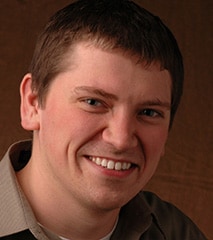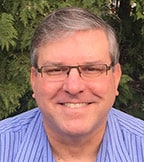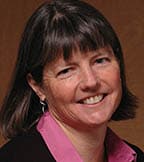

SCS Engineers’ Phillip E. Gearing, PE is a winner of the SWANA 2017 Young Professional Award from the Wisconsin Badger Chapter. The Solid Waste Association of North America honors individuals like Phil who make a significant difference in the solid waste industry.

Phil represents the best of the young professionals working within Wisconsin’s solid waste industry. Clients, contractors, and team members appreciate Phil’s leadership and passion for doing the job right.
He is a dedicated father of three children and an avid fan of all things Wisconsin, namely Badger sports, Green Bay Packer football, and Brewer baseball. Wisconsin from head to toe! Phil was raised on a dairy farm in Jackson County near Merrillan and attended the University of Wisconsin – Madison where he earned his B.S. in Geological Engineering, Geology, and Geophysics.
Phil serves clients out of the SCS Engineers office in Madison, WI.
Read about Phil’s work and SWANA award here.
Despite the fact that you have taken every precaution, hitting utility lines or other hidden infrastructure is still relatively common. Even after all the records are consulted and metal detector tests completed, you can dig up an entire storage tank that wasn’t accounted for or find a random pipe with no apparent usefulness.
Having a tool that can get you down there without damage is a significant benefit to those in the field. SCS recommends using the Hydrovac or Air Knife technologies, tools that can save money and time when working on sites with sensitivities or a longer historical background when the risks are highest.
SCS uses these tools when drilling at a transfer station near older or deeper power lines. We find utilities can be buried deeply below ground or are not encased in metal pipes, making metal detectors useless.
When remediating a historic property for developers with nearby utility lines and there’s a question about the accuracy of the records, it is far safer and cost efficient to use these newer technologies to dig a hole as small as for setting a mailbox, or as large as digging an entire site for construction.
The Hydrovac and Air Knife will both remove soil cover and allow you to see any underground utilities or infrastructure before excavation or drilling. The Hydrovac uses pressurized water and a vacuum system to remove soil. The Air Knife accomplishes the same thing using compressed air instead of water.
SCS Engineers can provide a range of equipment sizes and capabilities including:
By Thomas Karwoski and Sherren Clark
About the Authors:
 Mr. Karwoski has 30 years of experience as a hydrogeologist and project manager. He has designed and managed investigations and remediations at existing and proposed landfills; and industrial, Superfund, military, and petroleum sites.
Mr. Karwoski has 30 years of experience as a hydrogeologist and project manager. He has designed and managed investigations and remediations at existing and proposed landfills; and industrial, Superfund, military, and petroleum sites.
 Ms. Clark has more than 25 years of experience in civil engineering and environmental science, with a technical background in both engineering and hydrogeology. She manages multidisciplinary projects including landfill design and monitoring, brownfield site investigation and remediation, and environmental management and permitting for private and public sector clients.
Ms. Clark has more than 25 years of experience in civil engineering and environmental science, with a technical background in both engineering and hydrogeology. She manages multidisciplinary projects including landfill design and monitoring, brownfield site investigation and remediation, and environmental management and permitting for private and public sector clients.
Links to SCS Services: CCR, Landfill, and Remediation pages.
What makes Sol shine so brightly?
For Solavann Sim it’s his positive qualities as an individual and his ability to work effectively using a multidisciplinary approach with his clients. Our industry’s strongest and most respected leaders are those who are considered collaborative, not fixated on making all decisions themselves or working in a silo. On the contrary, innovation happens at the crossroads of different disciplines and that is where Sol shines brightest.
Sol’s landfill gas design-build and operations experience, along with his knowledge of hydrogen sulfide treatment programs, help prevent and mitigate potential problems quickly. His comprehensive technical and field competence, along with his clients, and his team comprised of staff in several disciplines approach solutions in various ways; each having unique perspectives but a common goal. Working collaboratively with clients the team solves complex challenges facing landfill owners and operators. Innovative solutions are often found where perspectives, ideas, and fields of expertise meet.
Read more about Solavann Sim and SCS Engineers LFG programs here.
See SCS’s 40+ years of innovative thinking at SCS Firsts an interactive list of client solutions, underneath News, Events, and Blogs.
Read and share the full article by David Greene, PE, here.
EPA recently established expansive new air rules affecting MSW Landfills. Implementation of the new rules places new responsibilities on both the regulated community and regulators alike. However, some of these responsibilities are unclear and have created unresolved issues that should be addressed in close consultation now with your state/local regulatory authority.
For example, if a landfill is “new,” the facility is now subject to NSPS Subpart XXX, which is fully effective. A design capacity and NMOC emissions rate report should already have been submitted.
If NMOC emissions from a facility exceed 34 Mg/yr, then the landfill will need to submit a GCCS design plan within 12 months of the date of exceedance and install and operate within 30 months (no later than May 2019 for those triggering with the promulgation of the rule). If a landfill is an “existing emissions source,” it will be subject to the new EG rule (Subpart Cf).
Landfill owners should maintain close contact with their state/local regulatory authority regarding the status of the regulator’s state implementation plan, due by November 2017. That state implementation plan will prescribe the required compliance dates for an existing landfill, likely to be no later than the 2018/2020 time period. In either case, owners should become familiar with the rule and stayed tuned as compliance guidance evolves to address the unresolved issues.
Contact SCS Engineers to discuss the regulatory status in your state at , or call your local representative.
The Environmental Research & Education Foundation (EREF) is one of the largest sources of solid waste research funding in the U.S., allocating approximately $1 million annually in research grants and graduate level scholarships. EREF announced yesterday that scholarship applications for the 2017-2018 academic year are now available.
The application deadline is May 3, 2017, at 5:00 pm (ET).
Applications will be considered from those who:
EREF Scholarships recognize graduate students pursuing excellence in solid waste management research and education. Recipients are chosen based on credentials and potential contributions to the solid waste industry and its scientific community.
Awards are based on:
All qualified candidates will be considered for scholarships without regard to race, religion, national or ethnic origin, citizenship, or disability. Applications from students outside the United States or studying abroad will receive equal consideration. Award decisions by the Environmental Research & Education Foundation and its directors are final and not subject to appeal.
For more information on EREF’s scholarships, as well as a link to the scholarship application, click here.
EREF is a 501(c)3 class charity that funds and directs scientific research and educational initiatives for waste management practices to benefit industry participants and the communities they serve. For the complete information on EREF funded research, its scholarship program and how to donate to this great cause, visit www.erefdn.org.
Are you approaching the required five-year review/plan re-certification for your facility’s Spill Prevention, Control, and Countermeasure (SPCC) Plan? Even if you’ve been through several cycles of performing five-year tune-ups on your SPCC Plan, you can make your next review easier and prepare yourself for future SPCC Plan re-certifications if you follow these five tips.
Start Early
Late renewals are a consistent pain point for many companies. To avoid being late with your next re-certification, start your review six months before your SPCC Plan is due for its 5-year review. If you are conducting the review internally, start by identifying the person who will be doing the review. If you are using a third party, this approach will help you go through the proposal/contracting process, so you are ready to conduct the actual review and complete the re-certification before the Plan expires.
Simplify Data Collection
One of the keys to a compliant SPCC Plan is to collect accurate data in the field about your facility’s oil sources. Streamlined data collection is of particular importance if you have a large facility or your oil storage changes regularly. The key to simplifying data collection is to make sure your reviewer has organized information to evaluate the compliance aspects of each source. Accurate data collection can limit the follow-up required from plan preparers to verify information, as well as minimize the potential for discrepancies. Moreover, particularly useful if a third party is auditing your Plan or if it is in review during an EPA inspection.
Reduce Redundancy with a Summary Table
One way to simplify your Plan is to use an oil source summary table to cover as much information as possible. A table can include each oil source and the aspects of how the oil source is compliant with the SPCC Rule. There may be areas in the Plan where you need to provide additional text discussion regarding oil sources to explain a compliance matter. In general, try to avoid duplicating information within the Plan.
Watch Out for Commonly Overlooked Areas
While secondary containment and overfill protection are key elements to review at each oil source, some reviewers forget to measure the size of containment structures. Dimensions need to be carefully measured in the field to verify and show sufficient secondary containment capacity in your facility’s SPCC Plan.
Another commonly overlooked area is facility drainage; specifically the overland flow in the proximity of each oil source, which is key to determining the potential receptors where spilled product can travel. These receptors could be storm sewers, ditches, wetlands, or waterways. You can discuss the protection of these receptors during your facility’s annual SPCC training. Swift action and concise communication during a spill can help limit your liability.
Use Targeted Annual Training
Many companies struggle to comply with the annual training requirement. One of the tripping points is trying to train all employees who handle oil for example. To avoid this pitfall, implement a tiered training program so you can focus the training content based on an employee’s responsibility level.
Spill recognition and notification through proper internal channels to get a spill cleaned up is an essential message for employees that occasionally handle oil. These employees could also be trained to aid with the initial control and response to a spill. A second tier may include team members who manage the SPCC Plan; they have additional responsibilities such as inspections of oil sources and spill reporting.
By Chris Jimieson, SCS Engineers
Chris Jimieson has over 17 years of experience supporting industrial, commercial, military, federal, state, municipal, and solid waste companies with environmental compliance. He has extensive experience building and reviewing SPCC and Storm Water Pollution Prevention Plans (SWPPP) and manages compliance assignments, providing computer-based training modules to meet employer training needs. Contact Chris at or 608-216-7367.

The Long Beach Business Journal published an article in February about the role of engineers in infrastructure design and investment. With discussion of an immense $1 trillion outlay at the federal level in the news, the LBBJ took a look at the roles engineers play in every aspect of infrastructure development.
President and CEO, Jim Walsh discusses the purpose SCS Engineers plays as an environmental consultant and contractor on infrastructure projects ensuring they meet environmental needs, as well as economic ones.
On March 1, each year facilities that use hazardous chemicals in specific quantities must file an EPCRA Tier II report identifying the chemicals with the State Emergency Response Commission, the Local Emergency Planning Committee, and the local fire department.
Easy to avoid mistakes and omissions in Tier II filings may lead to civil penalties of as much as $54.8K per day. Most cited violations involve just a few common chemicals such as ammonia, sulfuric acid inside equipment, and an EHS that is a component of mixtures. These are often overlooked or thought to be exempt from reporting because the threshold for reporting may be low.
Rather than risk non-compliance, ask the professionals at SCS Engineers about common chemical thresholds, voluntary self-disclosure, and EPA’s audit policies.
Read our most recent EPCRA Technical Bulletin, or contact us at .
We hope you find this Waste360 article helpful.
http://www.waste360.com/fleets-technology/what-s-next-route-optimization
Other related articles of interest include financing and rate studies see Solid Waste Management Services at SCS Engineers.
Rogoff will be leading a panel at this year’s WasteExpo in New Orleans. The session on Route Optimization Management will take place on Monday 8 at 9:00 AM. See more presentations and topics at Waste Expo 2017.
Chad Milligan, P.G. of SCS Engineers is presenting a holistic approach to water quality treatment at mines.
About the Presentation:
Disposal of produced fluids from industrial processes is becoming more challenging with time. Options such as surface discharge through NPDES or trucking can be cost prohibitive, requiring an evaluation of alternative methods such as disposal via deep will injection.
Such problems have arisen for three coal mines in Illinois. Two of the mines generate high chloride native groundwater that infiltrates the mine and is then pumped to surface retention ponds prior to treatment and disposal. The third mine generates fluids from multiple sources including a coal fire power generating plant and a coal combustion residual landfill. These fluids will be also stored in surface retention ponds prior to treatment and disposal.
An evaluation was performed of the treatment and disposal of native groundwater infiltrating the mines using a holistic approach. The approach includes an evaluation of the water quality by assessing the chemical and physical characteristics of water, water quantities, water treatment system, geochemistry, and applicable disposal well characteristics. Current evaluations have identified specific minerals that may be precipitating within the disposal well diminishing well capacity and biological fouling originating within the mine itself that has substantially increased pretreatment filtering costs.
The treatment and disposal of produced powered generating fluids has introduced a new level of review by not only including the general physical and chemical characteristics of water treatment, but also the review and evaluation of the plant-wide water budget identifying the source of fluids within the plant, and also a thorough characterization and review of solid waste regulations such as the Resource Conservation and Recovery Act.
This presentation will compare the source and treatment options of the produced waters from these three coal mines.
About Chad Milligan
Chad Milligan is a licensed professional geologist in the states of Kansas, Louisiana, and Illinois. He has a Bachelors degree in Environmental Chemistry from Emporia State University and a Master’s degree in Environmental Science from Wichita State University. Chad is responsible for the permitting and regulatory compliance of Class I and Class II disposal wells, Class III salt solution mining wells, LPG storage caverns, and Class V cavern stabilization wells.